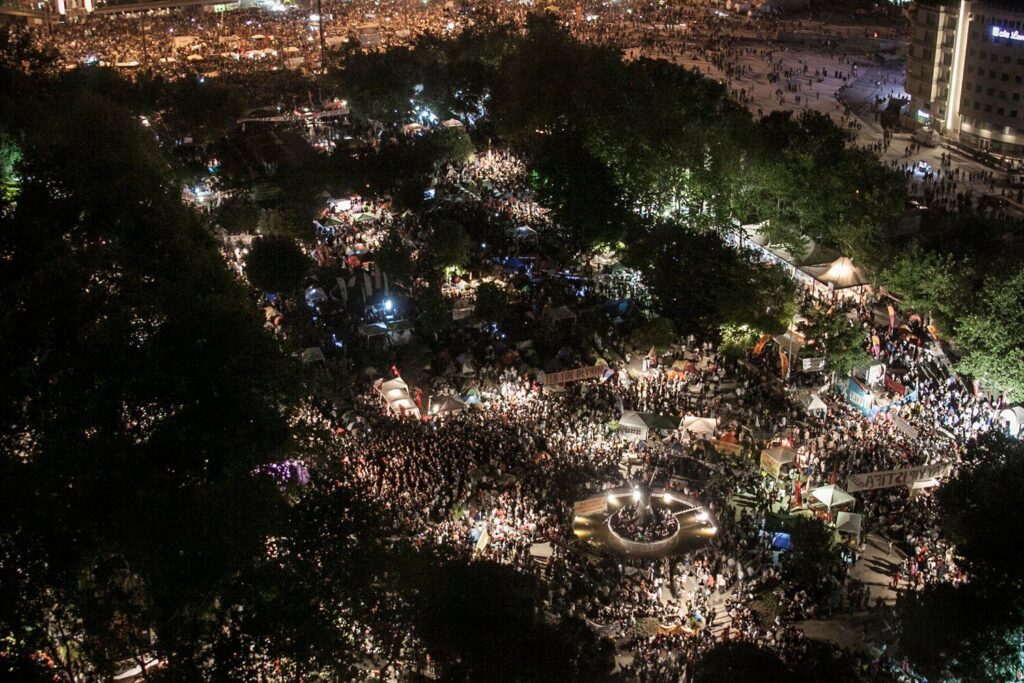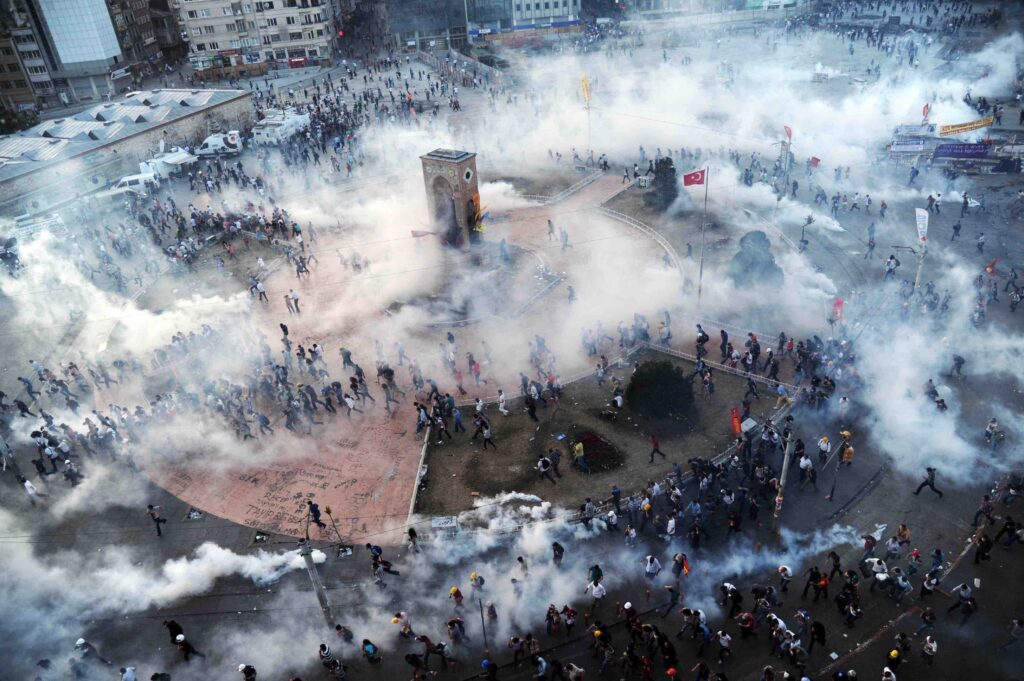Ecehan Balta
May 28 marks the beginning of the resistance against the AKP government’s plan to build an army barrack in the location of Gezi Park in Istanbul’s Taksim Square. The harsh police repression that followed spread the news across Turkey overnight. The protests, which lasted for more than a month in 80 (out of 81) provinces of Turkey, with 2 million people participating according to police records, were the largest protests the country had ever seen. During these protests, 8 young people were shot dead by the police in different cities across Turkey. There are still civil society leaders and lawyers in prison with the accusation of inciting the Gezi protests.
What led to the Gezi protests
After coming to power in 2002, the AKP government embarked on a massive attack on nature in order to overcome the effects of the economic crisis of 2001, which led to the collapse of many state-owned banks and massive impoverishment. The plunder of nature, with the building of mines, power plants, new bridges, roads, and dams, turbocharged a process of “accumulation through dispossession” (as Marxist geographer D. Harvey characterizes it) and sparked local environmental revolts all over the country. In this respect, the defense of nature and the urban fabric was a leitmotif for a lot of movements and actions.
On the other hand, the internal tensions within the AKP government about how to handle the issue and its increasingly repressive clampdown, which led to great violence during the defense of Gezi Park, provoked significant problems to the regime.

Repression and retreat
The forced evacuation of Gezi Park by the police, the removal of the tents of those who had been keeping vigil there, and the cutting down of trees by construction companies’ equipment were met with physical resistance by the protesters inside the park. The number of protesters gradually increased; by the evening of the next day there were tens of thousands of people in Taksim Square and Gezi Park. For 20 days, despite continuous police attacks, a political and social life was created inside the park with its own forums, library, canteens, etc. Although there was discussion about how this experience could be also replicated elsewhere, it is definitely true that it served a transformative function for those who were present.
On the other hand, in areas and cities outside Gezi Park, the protests turned into a constant clash with the police. In Ankara, barricades were erected for nearly 40 days and were removed only after a big operation by the police. In other cities, the police attacked people out of nowhere, even people sitting at bus stops.
Trade unions and other movements were not indifferent to the Gezi protests. Revolutionary labor and civil servant unions called for a general strike. But what really surprised the government and made it take a few steps back was the spontaneous explosion of this movement and the fact that the security forces were confronted with a mass of young people they had never encountered before. As the demonstrators occupied Kızılay Square in Ankara and Taksim Square in Istanbul, the police were looking for familiar faces among them- they only found a few. Most of those people were taking to the streets for the first time. At the same time, the AKP’s promise of “democracy” and power struggles inside AKP led to a period of inaction and hesitancy on the part of the police.
The movement subsided when the government promised that Gezi Park would not be rammed down, at the end of June. That was certainly a victory for the protests. Although there were discussions around the idea of a continuation of the Gezi Park occupation, it was estimated that this was not sustainable.
After the protests ended, the initiative which coordinated the Gezi Park protests called for the establishment of forum-like horizontal organizations in all parks across the country. Although this call found some response, with the exception of one forum (the Yoğurtçu Park Women’s Forum), these structures also fizzled out in the year following Gezi.

Demands and the problem of the political subject
The defense of Gezi Park was the main axis of the movement. In other cities, however, we witnessed the spontaneous emergence of a general outburst of anger, especially from young people. These movements were further fuelled by the increasing number of people killed in police shootings, and the slogans “government resign!” swept the country. It is important to note that not a single minister resigned during the course of events.
What was most striking during this period was that the socialist left and the Democratic People’s Party (the Kurdish based HDP), both inside and outside Gezi Park, did not have the power or even the will to lead the movement.
Although the Gezi protests inspired hundreds of thousands in Turkey and worldwide, although they opened up a period of revival for the environmental and social movements, they were not able to kick out the hated Erdogan regime.
Imperative for this to happen, was the creation of a political subject with a socialist programme that would unify the forces of the Left and the social movements. Some on the Left arrived at this conclusion and tried at different times to build small or large political umbrellas; but those attempts were either made too late or they failed to build a structure that would be able to attract fresh layers and have the algorithmic growth effect they expected.
Gezi’s international character
From the Arab Spring to Spain and Greece, the 2010s saw a serious wave of revolts, protests and uprisings in the region surrounding Turkey. In 2011, the Occupy movement had started to grow and spread. Then, during the Indignados protests in Spain, the slogan “Be quiet, the Greeks are sleeping” was heard. This prompted the Greek movement to start its own occupation of Syntagma and other squares. The Arab Uprisings and the Kurdish Spring, which started in Tunisia and Egypt and then spread across the Arab and Kurdish geography, also pointed to a radical transformative dynamic in the Mediterranean area. The Gezi protests, which joined this wave of rebellion, were also an expression of the anger towards the economic policies flowing from the ‘07-’08-’09 financial crisis and a strengthened belief in the masses’ capability to inflict change.

A crucial legacy
The Gezi Park protests presented an important opportunity for all those who characterise themselves as socialists to see their weaknesses within the movement and learn lessons. Unfortunately, we cannot say that this opportunity has been fully utilized.
The socialist movement had the opportunity to get in touch with the people who were politicized during Gezi and to build a relationship based on the experience of struggle. The encounter between young Kemalists and Kurds was one of the most unique aspects of the Gezi protests. The fact that these two groups, who until then had denied any relationship and were at odds with each other, came together to resist oppression opened up channels of communication between them.
The horizontal organization on which the Gezi Protests were based started to create a new culture within the left: people were able to openly express their thoughts and feelings during the meetings, and there were even hand gestures developed to communicate. “The defense of the commons” entered the agenda of the Turkish socialist movement as an important issue. At the same time, experiments such as urban gardens and occupied houses began to flourish.
The Gezi Protests showed people in Turkey that they can build resistance, they can score victories, they can organise and take their destiny into their own hands. That’s why the Gezi Park protests have a historic significance and they have left their mark on events, the Left and the movements.













